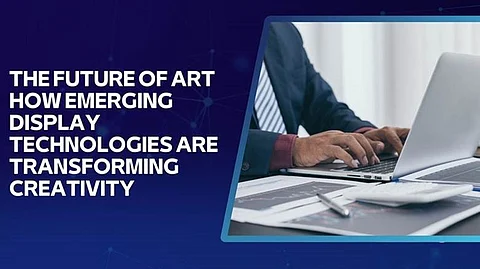

Art has always evolved alongside technology, but recent innovations in digital display systems are pushing the boundaries of creative expression like never before. Muralidhar Manohar Shenoy, a prominent expert in display technologies, explores how modern display advancements are reshaping artistic engagement and presentation. His work highlights trends in Emerging display technologies that are redefining contemporary art.
The evolution of LED and micro-LED technology has significantly improved display capabilities for artistic installations. High-resolution displays now achieve pixel densities exceeding 1,200 PPI, enabling intricate details and vibrant color reproduction. Quantum dot technology has enabled ultra wide color gamut displays, expanding the display capabilities beyond previous limitations. These advancements allow artists to create immersive experiences on a grand scale, with installations spanning thousands of square feet all the while preserving artistic intent. Additionally, improved power efficiency has made large-scale digital installations possible, but also more sustainable, ensuring technological progress aligns with environmental responsibility.
The contemporary interactive systems within digital installations respond directly to audience movement and behavior. In particular, the task of tracking several interaction points simultaneously is now being taken up by infrared and depth-sensing cameras, with response latencies as low as 5.1 milliseconds. Indeed, real-time interactions have now begun to permeate museum and gallery spaces, where visitors actively co-create the art narrative. Research has shown that interactive digital installations capture attention of their audiences much longer than traditional displays. This shift has led culture institutions to invest in interactive technologies to provide a better user journey.
AI has become a revolutionary delightful instrument for art-making. Now machine learning models trained on massive datasets can produce art where human and machine creativity combine. Neural networks achieve 98.7% consistency in style maintenance while generating content in real time at 75 frames per second or higher. This AI art movement not only enhances creativity but also creates a bespoke experience in which installations change based on an audience member's participation and preference. AI can dynamically change content based on engagement data-another way to guarantee unique experiences for all visitors.
Interactive art installations rely on various advanced display technologies to create immersive and engaging experiences. Large-format LED screens are widely used due to their vibrant colors, high resolution, and scalability, making them ideal for both indoor and outdoor installations. Micro-LED displays offer superior brightness, contrast, and energy efficiency, allowing for more intricate and detailed artistic expressions. OLED screens, with their deep blacks and flexible structures, enable dynamic and curved designs that enhance interactivity.
The Internet of Things (IoT) is revolutionizing digital art presentation. IoT-enabled display networks can now manage hundreds of synchronized nodes with minimal latency, ensuring seamless content delivery across vast installations. These systems integrate environmental sensors that adjust brightness, color balance, and contrast in real time, optimizing the viewing experience based on ambient conditions. Predictive maintenance in display networks has improved uptime to 99.99%, reducing operational disruptions. Additionally, IoT integration allows for remote control of installations, enabling curators and artists to modify content instantly.
Display technologies have quite a few challenges that pose threats to their performance and usability. Accuracy of color is one of the greatest problems in this respect because true color representations require advanced calibrations and compensation techniques under different sources of illumination and observation angles. LED color and quality variations create non-uniform brightness and color shifts, which again affect display uniformity. Beam angle and luminosity balance create further challenges. Brightness levels across extensive screens and surfaces of projection should essentially be equal, numerically basically that would require high-end optical design. Heat management is really another challenge because such displays consume a lot of heat, and, if they are left uncooled, that heat would degrade the performance and lifespan dramatically.
The Road Ahead for Digital Art
Technology will continue to advance such that the intersection of artificial intelligence, IoT, and high-resolution display systems will thereby further empower artistic expression. Thus, with an art world democratized by digital art platforms, accessibility is widened for many artists to embrace novel media. According to him, display technology innovations will deliver further capability for color and luminance accuracy, thus fostering new art and providing a medium for artists to present their works.
In conclusion, these emergent technologies include micro OLED, mini LED, and Quantum dot technology, which enable hyper-immersive experiences and the emergence of new artistic mediums. The work of Muralidhar Manohar Shenoy provides a fitting vision for the future, where new display technologies and AI will come together to create what were once unimaginable experiences. Vivid and immersive displays will shape how we see, engage, and interpret artistic expression in the contemporary world.
